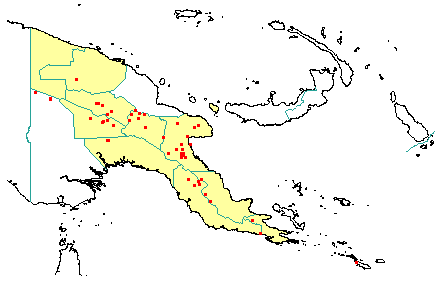
in PNGplants database
PNGTreesKey – Elaeocarpus polydactylus Schltr. |
Barry Conn (NSW) & Kipiro Damas (LAE).
Guide to trees of Papua New Guinea
Copyright held by the authors, National Herbarium of New South Wales, and Papua New Guinea National Herbarium
Botanische Jahrbucher für Systematik, Pflanzengeschichte und Pflanzengeographie Vol. 54: 119 (1916)
Other Literature: M.J.E. Coode, Handbooks of the Flora of Papua New Guinea 97-101 (1981) Fig. 22.
Family: Elaeocarpaceae
Dicotyledon
Timber Group: Commercial hardwood
Field Characters: Large canopy tree (up to 30 m high) or Small sub-canopy tree (up to 20 m high); Bole cylindrical (up to c. 30 cm diam.); straight (bole mostly 6-10 m long); buttresses buttresses absent; spines spines absent; aerial roots aerial roots absent; stilt roots stilt roots absent; Bark pale red or reddish brown, rough, fissured; Subrhytidome (under-bark) white, red, brown, or mottled; less than 25 mm thick, 6.0-8.0; bark blaze consisting of one layer; faintly to non-aromatic; outer blaze white or yellow (pale (straw-coloured), markings absent, slightly fibrous; inner blaze white or yellow (pale (straw-coloured), markings absent, slightly fibrous; bark exudate (sap) absent; terminal buds not enclosed by leaves.
Indumentum: Complex hairs absent; stinging hairs absent; mature twig indumentum (hairs) present when young or soon absent, hairs dense to sparse.
Leaves: Leaves clustered at end of branches to spaced along branches, spiral (leaves occurring singly at a node and arranged spirally up the branchlet), simple (a leaf composed of a single blade); petiole present, winged, attached to base of leaf blade, not swollen; leaves broadest above middle to broadest at or near middle, 1.5-14.0 cm, 5.0-7.0 cm; symmetric, serrate to dentate (toothed) (shortly (obscurely so_), not dissected or lobed, obtuse to acute, venation pinnate, secondary veins open, prominent, intramarginal veins absent; leaves lower surface pale green, upper surface dark green, indumentum (hairs) usually absent or present when young, indumentum (hairs) dense to sparse; absent; domatia absent; stipules absent.
Flowers: Inflorescence axillary, flowers on an unbranched axis, cones absent; flowers bisexual, stalked, flowers with many planes of symmetry, 3.0-5.0 (-5.5) mm long, diameter small (up to10 mm diam.); perianth present, with distinct sepals and petals whorls, inner perianth white (cream-coloured); 5, free; stamens 14-20, present, free of each other, free of the perianth; ovary superior, carpels joined (when more than one), locules 3 (-5); styles solitary, 1.
Fruits: Infrutescence arranged on unbranched axis, fruit 8.0-18.0 mm long, blue or dark black, not spiny, fleshy, simple, indehiscent, drupe; seeds 1 (-2), about 10 mm long, not winged, broad (as wide as long), seed 1-10 mm diam.
Distribution: West Sepik, East Sepik, Morobe, Western Highlands, Eastern Highlands, Southern Highlands, Gulf, Central, Northern & Milne Bay.
 | Botanical records in PNGplants database |
Notes: Notes This is a morphologically variable species, with the different forms distinguished on leaf size, leaf texture and number of flowers in the inflorescence (refer to M.J.E. Coode (1981), in E.E. Henty (Ed.), Handbooks of the Flora of Papua New Guinea, volume 2, p. 99 for further details). These forms are not recognised in this treatment of the species.